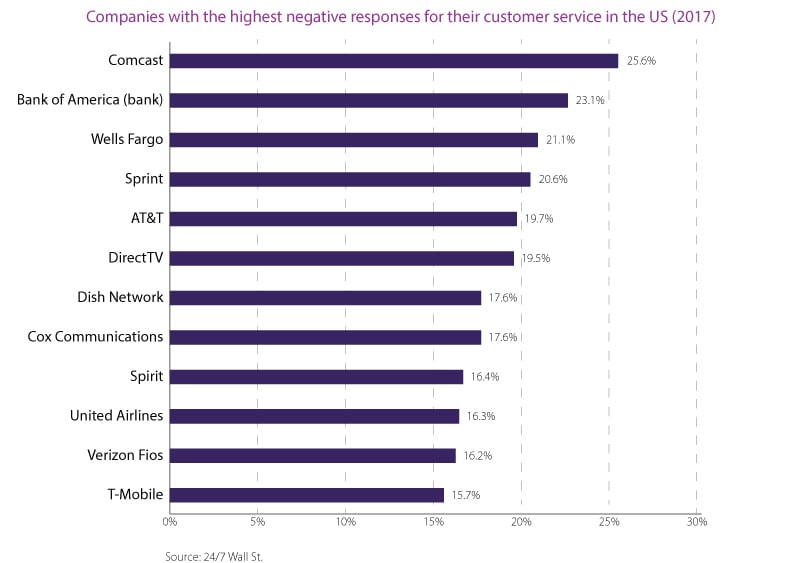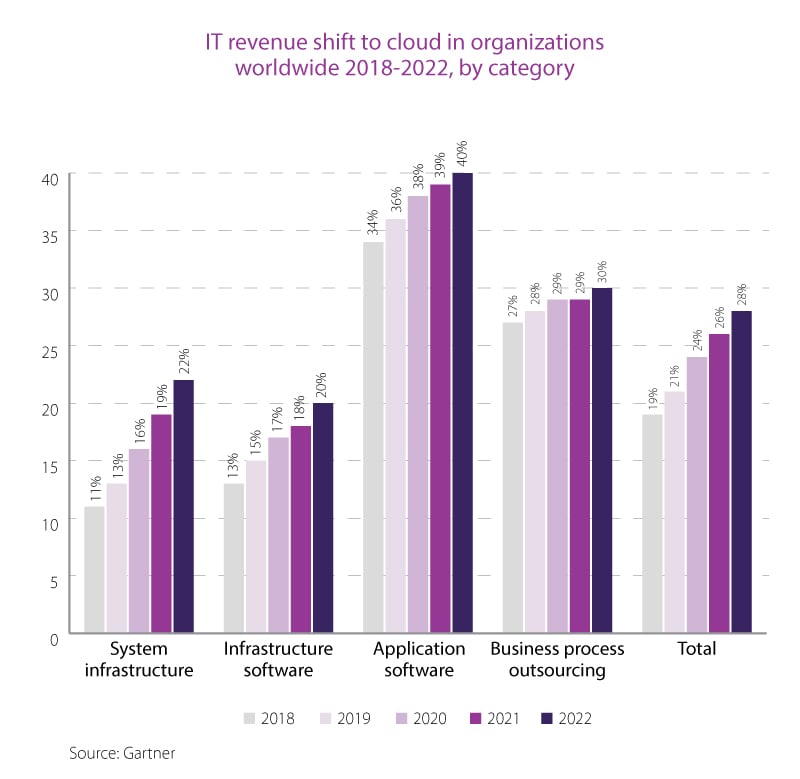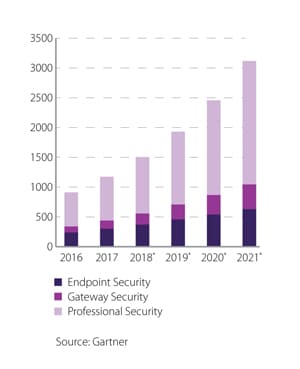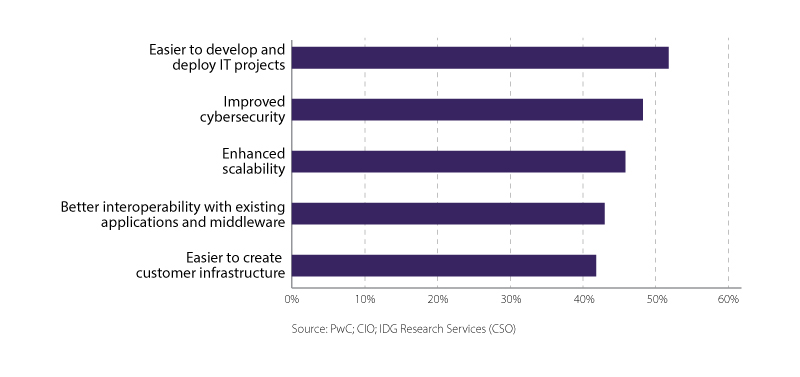According to the 2018 American Customer Satisfaction Telecommunications Report1, customer service performance lags behind other functions. Telco consumers report a variety of complaints, ranging from slow networks and data transfer speeds to poor call center support. In many cases, consumers contact customer service as a result of other issues they encounter.
What appears to be a customer service problem at the first glance, is actually triggered by the customer’s dealings with another part of the company, and customer service becomes a consequence of other issues. In many cases, a problem starts much earlier - for example, due to inaccurate validation, customers may be charged for services they never requested or used. For highly complex telecom processes such as order capture, service plans, order validation, provisioning, and network integration, failure in one area creates a domino effect, leading to critical errors that cause unnecessary expenses for inaccurate billing and poor customer service.
Customer service and billing processes are crucial to customer experience, as they essentially define the relationship between the telco and its customers. It’s essential that telcos enhance these touch points.

If any aspect of the billing process causes friction with telecommunications customers, it will not only degrade the overall experience but also put telcos at the risk of losing customers.
In an industry with widespread dissatisfaction, the ability to provide a more intuitive, positive consumer experience strengthens customer loyalty and even attracts new customers. Telcos must earn and keep the trust of their customers, but how?
Beyond a solid product and reliable network, they need to think through what it means to have transparent and accurate optimization of the customer experience. What is the customer journey for each persona, what data visualization is needed to provide transparency, and what operational metrics underpin the capstone one like net promoter score? The continuous stream of new technologies and enhancements offers more tools and choices for telecom companies to improve customer experience. From identifying customers, providing multiple channels, and even capturing sentiment, it is genuinely a step function change opportunity. However, before they attain this customer-centricity nirvana, telcos need to modernize their core systems, so that they have a dependable platform that allows rapid integration as leaders identify new tools and approaches.
Useful technologies preventing the domino effect caused by fault-based triggers
Cloud-orientation and network visualization
Networks increasingly rely on cloud services, and IT infrastructure operators are also following suit.
Network virtualization has enabled a new architecture model which allows systems to evolve freely with user scale and demand.
In simple terms, this cloud-native architecture means that IT operators can work naturally in the cloud IT infrastructure. However, a cloud native IT operator also has to provide the ability to manage vast amount of virtual hardware and software resources in real time. This capability, in turn, requires a transition to a fully automated DevOps operating model. This transition is not incremental and cloud volume will continue to increase in a non-linear fashion. Hyperscale exploitation and other web-scale methods will become key future operational competencies.2
These competencies are likely to enrich the customer experience through the next few years at least.
Cloud technologies will improve infrastructure efficiency, increase throughput speed, and reduce maintenance costs.
The combination of these operational benefits will drive customer experience improvement.3

Shift left
The term “shift left” has been around for some time. It broadly means the process of pulling forward traditional late-stage development activities earlier in the software life cycle. Developers are directly involved in these stages, rather than transferring them to individual teams.
Testing is a significant shift left activity, using approaches such as development through testing, where developers write tests before coding and with continuous integration, where tests are automated to run tightly aligned with code production. This early stage activity includes what traditionally has been called quality assurance, performed much earlier in the cycle. Our research has shown a reduction in design-to-deployment cycle time since engineers perform work in parallel and minimize service transfer between functions. This improvement also reduces rework cost because engineers can identify problems and eliminate them earlier.
Increased developer awareness of quality requirements and organization testing4
This method of testing improves software quality, allowing telcos to develop offerings and make changes during the development phase. This earlier development, in turn, reduces the cost of software testing, the probability of false positives, incorrect triggers, incorrect operation of programs and services, and improves overall customer experience.
Implementation of AI and robotic process automation
Telecommunications providers should accelerate their journey to continuous automation to perform repetitive work more efficiently.
Artificial intelligence applications in the telecommunications industry use advanced algorithms to search for patterns in data, allowing them to detect and predict network anomalies and also enable operators to solve problems before customers are adversely affected.
Increased productivity, reduced costs, improved efficiency, and improved customer service have popularized RPA’s appeal and can provide the hard business case needed to take the step from pilots to implementation at scale.
Workflows across departments can be automated and then duplicated (with some customization) across businesses and geographies. As software robots take over manual work, it frees the staff to perform more critical tasks. Analytics is a natural complement to RPA, as the combination of keystroke data and analytics can highlight opportunities to eliminate trivial work, not just automate it. Intelligent automation research has shown that this allows operators better opportunities to expand their business and respond to market situations like growth and temporary demand fluctuations.5
RPA also reduces the gap between information sources. Software robots effectively track employee actions and easily access the data they need to work. RPA’s low invasiveness allows use with existing configurations. This low threshold for interfaces and integration will aid to share data.6
Unfortunately, it also raises legitimate concerns about personal privacy and the limits of employee monitoring. That is why governance is an integral component of any automation initiative so that leaders include thoughtful humanistic design considerations as they develop the operating model. The use of intelligent automation has demonstrated significant cost reduction and efficiency improvements in telco AT&T’s customer intelligent agent implementation across 40,000 agents. It has enabled them to improve their customer service while reducing costs and allowing investment in revenue growth areas. Beyond the high profile examples, telcos can highlight the everyday wins to maintain focus on these initiatives and accelerate adoption at scale.
Improving organizational agility
According to a leading research firm, telecommunications companies need to modernize their IT landscape to accelerate their transformation and enhance their long-term flexibility. If they succeed in this, they will have every opportunity to prosper in the over the top (OTT) world. If they fail, they will lose this race.
However, even as operators are preparing to become more flexible, our research indicates a discrepancy in the operator attitude.
Despite their awareness of the fundamental technology issues, clients tend to consider the lack of flexibility to be an industry problem and not a priority for their organizations.
While awareness bias and caution may be understandable, taking a slower pace on modernization initiatives is dangerous for the opportunity cost it carries, especially if competitors move forward aggressively.
Modernization includes consolidation of data and systems, BSS/OSS revision, emphasis on digital skills and interaction, and improved management. Artificial intelligence has a role to play in modernization, to optimize code that is used and identify integration points intelligently. This broad vision requires additional steps - early wins can validate ambitious long-term goals, which in themselves need constant re evaluation and clarification. The introduction of cloud technologies accelerated through partnerships, can improve centralized IT management, which will also focus on innovation in products and providing excellent customer experience.7
A structured approach to the development of digital services
Disruptive business models will depend on the implementation of selective growth programs. This agenda should focus on carefully selected vertical markets and segments that are supported by new value chain relationships that can help operators quickly respond to opportunities and risks. To achieve this type of positioning and flexibility, operators must clearly distinguish between different uses of the Internet of Things, based on their unique combination of capabilities.
To maximize these opportunities, operators have to thoroughly understand vertical-specific ecosystems to ensure optimal financial returns within an acceptable risk and reward framework.
Telcos also need to align people and processes to increase the credibility of emerging use cases and build more consultative relationships with customers to deliver value added offers more effectively. Telecommunications firms can maximize their share of consumed IoT, if they entirely use their differentiated capabilities in customer experience, analytics and security. It is the biggest story not talked about as a telco – the ability to finally take back monetization leadership, after two decades of providing the backbone for internet companies to get rich with asset-light business models.
Global Internet of Things security spending 2016-2021, by segment

Open source software
Open source software has come of age, reaching enterprise-class credibility and maturity with full stacks to address core business functions. This license free, consortium approach tilts its cost in integration and contextualization for endpoint application. The open source mix complements the telcos approach as the authentic communications technology backbone of the internet.
As open source has proven stability and scalability, it has allowed telcos to partner more effectively with a broader range of enterprises, and generate creative, competitive responses to the FAANG and BAT companies.
Open source software provides telcos with a higher control level over the network and a flexible environment for the rapid development and launch of new services.
Cost may not be the main factor for telcos to provide excellent customer experience, but it is a significant consideration for internet and cloud computing giants, who must seek to lower internet access cost to increase market coverage and implicitly improve their customer service.8
Open source software has several advantages:
- Flexibility
- Freedom
- Security
- Responsibility
- Cost
Open source software has long-term viability potential. Unlike proprietary software, open source can be modified and extended by any developer familiar with the source code. This flexibility gives businesses freedom and ensures long term viability. It provides abundant opportunities for new use cases, as well as testing to harden code and ensure stability.
Open source software is often supported by many developers, whose skills can be in high demand, creating a virtuous cycle: developers invest their time in an open source platform, which gives it credibility, which provides more demand for developers with those skills, which leads to more adoption of that software, which drives more demand for developers. As a result, open source projects can drive technology innovation, which can spur innovation within the internal operations of telecommunications companies, indirectly improving customer service capability.9
Top benefits of open source software (2016)

Software asset management
Software Asset Management (SAM) gets the most from each life cycle across a software portfolio. Too often considered compliance and “check the box” activity, SAM can reduce cost in the complex and dangerous world of cloud and cybersecurity. Proper identification and adequate funding of these initiatives can also help IT professionals identify and manage risk properly, which is often ignored or considered unimportant as a formal initiative in its own right.10
Effective software management allows IT professionals to keep up with the growing volume and complexity of corporate software assets and associated licensing agreements. The complexity and struggle to determine the actual number of software licenses deployed, leads to both underutilization and overuse. A good SAM program can reduce the costs associated with both. It can also help an organization better manage security threats, due to unauthorized or inappropriate software. Proper application of these technologies can also optimize and improve customer experience.11
The way ahead
Data availability and ease of use have elevated consumer user experience expectations. While many large companies are showing the way for better customer service, operators still lag for both technology and people reasons. The transformation of existing platforms, systems, and processes is critically important for the creation of new competencies in the field of digital technologies.
Transformation is a massive task and requires accurate monitoring, evaluation, and reassessment of progress. Not all operators pursue their transformation goals at the same speed. Long-term goals should also be flexible, given the potential for further failures and shifts in the regulatory and technical landscape.12
We recently surveyed over 1,000 companies, including more than 100 telco enterprises globally. Telcos have a digital maturity index larger than most industries (61.9/100.0, vs. an overall average of 57.4). However, even in the telco industry, there is significant dispersion between top performers and those lagging, and from country to country. This gap suggests that operators need to understand their unique operations and their customers.
A good starting point is to follow the customer journey for each persona and the sometimes complex details associated with the underlying processes. These complex details include buying, billing, using services, and updating network services. All these points of contact are essential for operators to understand and use their resilience. To achieve longevity and lasting impact, they must provide customers with a distinctive experience through transparent and accurate modernization and innovations.
References
- https://www.theacsi.org/news-and-resources/press-releases/press-2018/press-release-telecommunications-2018
- https://www.marketwatch.com/press-release/telecom-cloud-market---global-industry-analysis-size-share-growth-trends-and-forecast-2018---2026-2018-10-10
- Advances in Communication, Cloud, and Big Data, Hiren Kumar Deva Sarma, Samarjeet Borah, Nitul Dutta, Springer Singapore
- https://www.softwaretestinghelp.com/shift-left-testing-approach/
- https://becominghuman.ai/4-ai-trends-that-will-transform-the-telecom-industry-in-2019-1bf0d58637cd
- https://www.unlockinsights.com/blog/value-rpa-telecom-industry/
- https://www.communicationstoday.co.in/services/indian-telecom-equipment-industry-will-5g-drive-the-future-growth/
- http://frankrayal.com/wp-content/uploads/2016/09/Will-Open-Source-Disrupt-the-Telecom-Value-Chain.pdf
- https://opensource.com/article/17/8/enterprise-open-source-advantages
- https://www.information-age.com/why-software-asset-management-overlooked-cios-123471877/
- http://www.information-age.com/four-ways-reduce-costs-software-asset-management-123466208/
- https://becominghuman.ai/4-ai-trends-that-will-transform-the-telecom-industry-in-2019-1bf0d58637cd





